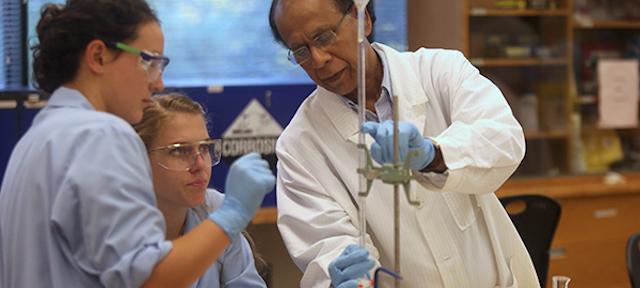Mystery of the Mummies

Eight Hampshire students and their professor gather around a table in the Cole Science Center. One issue tops their agenda on this cold winter morning: the health of the people in a faraway Chilean fishing village.
Eight Hampshire students and their professor gather around a table in the Cole Science Center. One issue tops their agenda on this cold winter morning: the health of the people in a faraway Chilean fishing village.
The students have uncovered a toxic secret. By performing laser analysis on hair and teeth samples taken from village residents, they've discovered dangerously high levels of heavy metals, particularly arsenic, in residents' bodies. Arsenic, it seems, has been endangering health in the region for centuries.
The discovery culminates a long, intense project for the team, led by Dula Amarasiriwardena, an analytical chemist who specializes in trace-metal detection.
It's the kind of globally focused work that Professor Amarasiriwardena, a native of Sri Lanka, believes today's college students should be doing. "We have to prepare students for the twenty-first century global village," he says.
Amarasiriwardena, a 20-year veteran on the Hampshire faculty, is certainly not alone in his emphasis on the global classroom. Many Hampshire professors have long incorporated field research in settings around the world not only into their classes, but into their own work as well.
Amarasiriwardena joined the faculty in 1987 after earning his doctorate at North Carolina State University; he received his bachelor's and master's degrees from the University of Sri Lanka.
A visit to Chile as a Fulbright Senior Specialist sparked his interest in what killed the region's ancient, famed Chinchorro mummies—and may be threatening the health of present-day residents.
Amarasiriwardena's team eventually determined that the main culprit is drinking water contaminated with arsenic. One of his students based a 2008 Division III (senior) project on an analysis conducted on a mummy hair sample from Chile, and three others undertook independent trace-metal research projects on hair samples.
Introducing as many students as possible to global issues and research is one of Amarasiriwardena's priorities. Each year he teaches an introductory environmental science course, Pollution and the Environment, that focuses partly on environmental issues in developing nations. He considers the class essential grounding for all science students.
"The goal is to get students thinking about these issues in a larger context," he says. "Today we are educating citizens of the world. Environmental repercussions need to be looked at through as broad a spectrum as possible."
Over the years, Amarasiriwardena's research has frequently taken him to Latin America. One project—a four-year, interdisciplinary effort—involved a collaboration with fellow Hampshire faculty members, spearheaded by Alan Goodman, professor of biological anthropology. The faculty team spent two weeks each summer from 2000 to 2004 in Mexico performing field studies on trace-metal nutrition and pollution in residents of the Solis Valley, a village located a few hours' drive from Mexico City.
"It was a very interdisciplinary effort. We all made contributions, and a lot of students got involved, too. It was a very productive project," Amarasiriwardena says.
Their findings established a link between lead found in hard tissue and the traditional, glazed pottery created and used by local people. Lead in the glazing process was contaminating the pottery and leaching into food.
"When you're exposed to these kinds of worldwide projects, you're exposed to the related history, cultural, and social contexts, in addition to exciting research in chemistry, which is perfect grounding for a liberal arts education," Amarasiriwardena says.
Photo courtesy of Museum in San Miguel de Azapa, Arica, Chile

